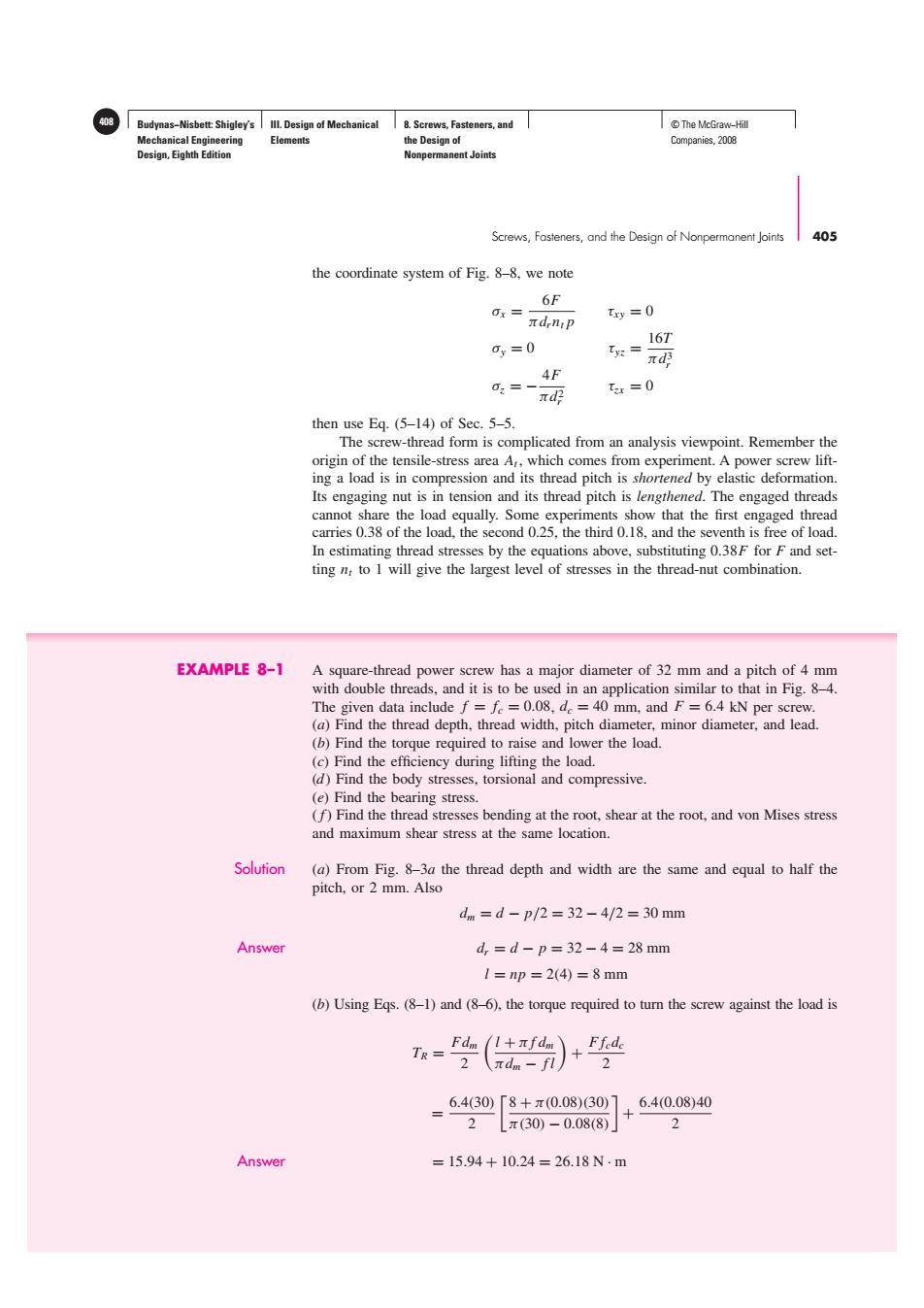正在加载图片...

Budynas-Nisbett:Shigley's Ill.Design of Mechanical 8.Screws,Fasteners,and T©The McGraw--Hill Mechanical Engineering Elements the Design of Companies,2008 Design,Eighth Edition Nonpermanent Joints Screws,Fasteners,and the Design of Nonpermanent Joints 405 the coordinate system of Fig.8-8,we note 6F 0x= Txy=0 πdrnip 16T 0y=0 ty:= πd 4F 02=- πd Tx=0 then use Eq.(5-14)of Sec.5-5. The screw-thread form is complicated from an analysis viewpoint.Remember the origin of the tensile-stress area A,which comes from experiment.A power screw lift- ing a load is in compression and its thread pitch is shortened by elastic deformation. Its engaging nut is in tension and its thread pitch is lengthened.The engaged threads cannot share the load equally.Some experiments show that the first engaged thread carries 0.38 of the load,the second 0.25,the third 0.18,and the seventh is free of load. In estimating thread stresses by the equations above,substituting 0.38F for F and set- ting n to I will give the largest level of stresses in the thread-nut combination. EXAMPLE 8-1 A square-thread power screw has a major diameter of 32 mm and a pitch of 4 mm with double threads,and it is to be used in an application similar to that in Fig.8-4. The given data include f=fe=0.08,de =40 mm,and F=6.4 kN per screw. (a)Find the thread depth,thread width,pitch diameter,minor diameter,and lead. (b)Find the torque required to raise and lower the load. (c)Find the efficiency during lifting the load. (d)Find the body stresses,torsional and compressive. (e)Find the bearing stress. (f)Find the thread stresses bending at the root,shear at the root,and von Mises stress and maximum shear stress at the same location. Solution (a)From Fig.8-3a the thread depth and width are the same and equal to half the pitch,or 2 mm.Also dm=d-p/2=32-4/2=30mm Answer d,=d-p=32-4=28mm 1=np=2(4)=8mm (b)Using Eqs.(8-1)and (8-6),the torque required to turn the screw against the load is TR= FdmI+πfdm) Ffede 2πdm-fl/ 2 6.4(30)8+π(0.08)(30)1 6.4(0.08)40 2 π(30)-0.08(8) 2 Answer =15.94+10.24=26.18N.mBudynas−Nisbett: Shigley’s Mechanical Engineering Design, Eighth Edition III. Design of Mechanical Elements 8. Screws, Fasteners, and the Design of Nonpermanent Joints 408 © The McGraw−Hill Companies, 2008 Screws, Fasteners, and the Design of Nonpermanent Joints 405 the coordinate system of Fig. 8–8, we note σx = 6F πdrnt p τxy = 0 σy = 0 τyz = 16T πd3 r σz = − 4F πd2 r τzx = 0 then use Eq. (5–14) of Sec. 5–5. The screw-thread form is complicated from an analysis viewpoint. Remember the origin of the tensile-stress area At , which comes from experiment. A power screw lifting a load is in compression and its thread pitch is shortened by elastic deformation. Its engaging nut is in tension and its thread pitch is lengthened. The engaged threads cannot share the load equally. Some experiments show that the first engaged thread carries 0.38 of the load, the second 0.25, the third 0.18, and the seventh is free of load. In estimating thread stresses by the equations above, substituting 0.38F for F and setting nt to 1 will give the largest level of stresses in the thread-nut combination. EXAMPLE 8–1 A square-thread power screw has a major diameter of 32 mm and a pitch of 4 mm with double threads, and it is to be used in an application similar to that in Fig. 8–4. The given data include f = fc = 0.08, dc = 40 mm, and F = 6.4 kN per screw. (a) Find the thread depth, thread width, pitch diameter, minor diameter, and lead. (b) Find the torque required to raise and lower the load. (c) Find the efficiency during lifting the load. (d) Find the body stresses, torsional and compressive. (e) Find the bearing stress. ( f) Find the thread stresses bending at the root, shear at the root, and von Mises stress and maximum shear stress at the same location. Solution (a) From Fig. 8–3a the thread depth and width are the same and equal to half the pitch, or 2 mm. Also dm = d − p/2 = 32 − 4/2 = 30 mm Answer dr = d − p = 32 − 4 = 28 mm l = np = 2(4) = 8 mm (b) Using Eqs. (8–1) and (8–6), the torque required to turn the screw against the load is TR = Fdm 2 l + π f dm πdm − f l + F fcdc 2 = 6.4(30) 2 8 + π(0.08)(30) π(30) − 0.08(8) + 6.4(0.08)40 2 Answer = 15.94 + 10.24 = 26.18 N · m�